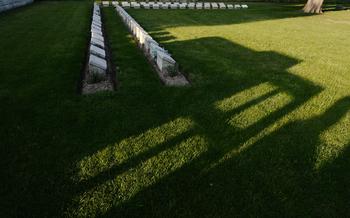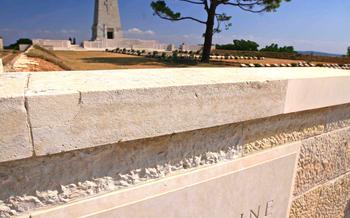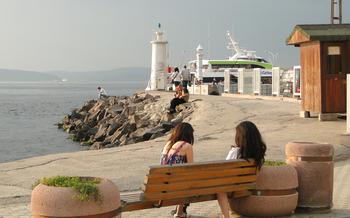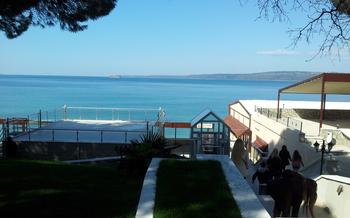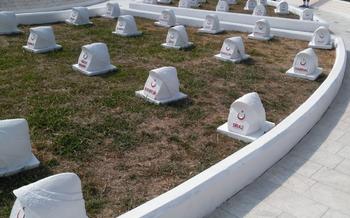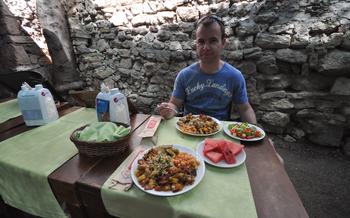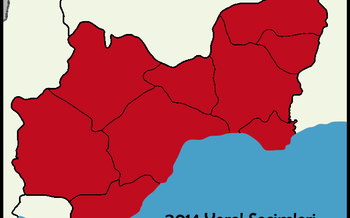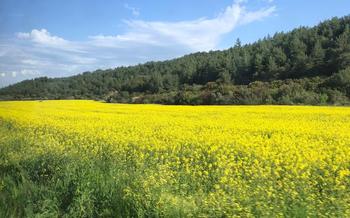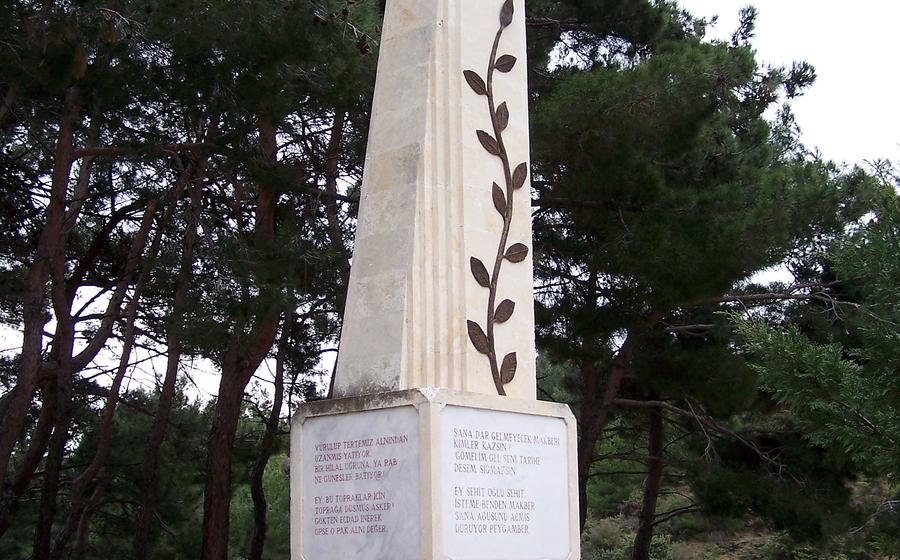
Eceabat War Cemeteries
- Eceabat War Cemeteries: A Historical Overview
- Location and Accessibility
- Types of Cemeteries
- Atmosphere and Significance
- Notable Graves and Memorials
- Guided Tours and Visitor Information
- Respectful Conduct and Etiquette
- Historical Context of the Battlefields
- ANZAC Commemorations and Ceremonies
- Visiting Tips for a Meaningful Experience
- Exploring the Surrounding Area
- Preservation and Conservation Efforts
- Educational Opportunities for Visitors
- Local Cuisine and Hospitality
- Insider Tip: Unique Perspectives
Eceabat War Cemeteries: A Historical Overview
The Eceabat War Cemeteries are a poignant reminder of the tragic loss of life during the Gallipoli Campaign of World War I. Located in the Çanakkale province of Turkey, these cemeteries serve as a solemn tribute to the thousands of soldiers who fought and perished on this historic battlefield. The battlefields of Çanakkale hold immense significance in the annals of World War I. The campaign, which lasted from April 1915 to January 1916, witnessed intense fighting between the Allied forces, primarily comprising British, French, and Australian troops, and the Ottoman Empire. The Commonwealth and Turkish armies engaged in fierce battles for control of the strategic Gallipoli Peninsula, resulting in staggering casualties on both sides. The Eceabat War Cemeteries stand as a testament to the sacrifices made by these brave soldiers, who fought with valor and determination. The cemeteries bear the names of over 57,000 soldiers, both known and unknown, who lost their lives in the Gallipoli Campaign. Their resting places serve as a poignant reminder of the horrors of war and the futility of conflict.
Location and Accessibility
The Eceabat War Cemeteries are situated in the Gallipoli Peninsula, within the province of Çanakkale in northwestern Turkey. The Gallipoli Peninsula juts out into the Aegean Sea, forming the southern shore of the Dardanelles Strait. The cemeteries are located approximately 12 kilometers southeast of the town of Eceabat, which serves as the main gateway to the peninsula.
Reaching the Eceabat War Cemeteries is relatively straightforward. Visitors can travel by car, taking the D550 highway that connects Çanakkale to Eceabat. Public transport options are also available, with regular buses departing from Çanakkale Bus Terminal to Eceabat. Once in Eceabat, visitors can take a taxi or local transportation to the cemeteries, which are well-signposted.
Parking facilities are available for visitors at each cemetery. However, it is important to note that the roads leading to the cemeteries can be narrow and winding, so caution is advised when driving.
Types of Cemeteries
Eceabat is the final resting place for soldiers who lost their lives during the Gallipoli Campaign. There are three main types of cemeteries in Eceabat:
-
Commonwealth War Graves Commission Cemeteries: These cemeteries are managed by the Commonwealth War Graves Commission (CWGC) and contain the graves of soldiers from the British Empire, including Australia, New Zealand, India, and Canada. The CWGC cemeteries are meticulously maintained and feature distinctive headstones with inscriptions commemorating each soldier.
-
Turkish War Cemeteries: The Turkish war cemeteries in Eceabat are dedicated to the Turkish soldiers who fought and died during the Gallipoli Campaign. These cemeteries are often located near the battlefields and feature simple headstones with the names of the fallen soldiers.
-
French War Cemetery: There is also a French war cemetery in Eceabat, which contains the graves of French soldiers who participated in the Gallipoli Campaign. This cemetery is smaller in size compared to the Commonwealth and Turkish cemeteries.
Atmosphere and Significance
The Eceabat War Cemeteries exude a serene and respectful ambiance, inviting visitors to reflect on the sacrifices made by soldiers during World War I. As you walk through the meticulously maintained grounds, the rows of headstones and memorials create a poignant reminder of the young lives lost in the conflict. The tranquil setting encourages contemplation and remembrance, allowing visitors to connect with the stories and experiences of the fallen soldiers.
The emotional impact of visiting these resting places is profound. Each headstone bears the name, age, and regiment of a soldier who fought and died on these battlefields. The sheer number of graves serves as a stark reminder of the immense human cost of war. The cemeteries provide a tangible connection to history, enabling visitors to better understand the sacrifices made by individuals from different nations who fought side-by-side.
The historical significance of the Eceabat War Cemeteries lies in their role as a testament to the bravery and resilience of soldiers from all sides of the conflict. These cemeteries stand as a reminder of the futility of war and the importance of peace and understanding. By visiting these hallowed grounds, visitors can gain a deeper appreciation for the sacrifices made by those who fought and died in World War I, and the lasting impact of their service.
Notable Graves and Memorials
Within the Eceabat War Cemeteries, visitors can pay their respects at the graves of prominent military figures and war heroes. The resting places of soldiers who displayed extraordinary bravery and leadership are marked with special headstones and inscriptions. Among them, visitors can find the graves of Major John McCrae, the Canadian physician and poet who penned the iconic poem "In Flanders Fields," and Lieutenant Colonel Mustafa Kemal Atatürk, the founder of the Turkish Republic and a revered military leader.
The cemeteries also feature memorials dedicated to missing soldiers and unidentified remains. These memorials serve as a poignant reminder of the countless individuals whose sacrifices remain unknown. Symbolic monuments, such as the Lone Pine Memorial and the Chunuk Bair Memorial, stand as testaments to the fallen soldiers and their unwavering courage.
By exploring the cemeteries, visitors can delve into the personal stories and experiences of those buried there. Each grave holds a unique tale of heroism, sacrifice, and resilience, offering a glimpse into the lives of the men who fought and died during the Gallipoli Campaign.
Guided Tours and Visitor Information
For those seeking a more in-depth understanding of the Eceabat War Cemeteries, guided tours are available. Led by knowledgeable historians or local experts, these tours provide insightful narratives of the battles, the fallen soldiers, and the significance of the cemeteries. Visitors can gain a deeper appreciation for the sacrifices made during World War I and the enduring legacy of the conflict.
Information centers and visitor services are also available within the cemeteries, offering maps, brochures, and historical guides to enhance the visitor experience. These resources provide detailed information about the cemeteries, the soldiers buried there, and the historical context of the battles. Online resources and websites, such as the Commonwealth War Graves Commission website, offer further information, including interactive maps and databases of the fallen.
Respectful Conduct and Etiquette
When visiting the Eceabat War Cemeteries, it is essential to maintain a respectful and dignified demeanor. Silence is observed throughout the cemeteries, ensuring a peaceful and contemplative atmosphere for visitors to pay their respects. Refrain from engaging in disruptive activities or conversations that may disturb the serenity of the surroundings. Visitors should dress appropriately, avoiding shorts, tank tops, or revealing clothing. Proper conduct includes avoiding touching or disturbing the graves, memorials, or any other artifacts within the cemeteries. By respecting these guidelines, visitors contribute to preserving the sanctity and reverence of these sacred resting places.
Historical Context of the Battlefields
In the throes of World War I, the Gallipoli Campaign unfolded as a pivotal event, leaving an indelible mark on the battlefields of Çanakkale. This ambitious military campaign, initiated by the Allied forces in 1915, aimed to seize control of the Dardanelles Strait, thereby securing a direct sea route to Russia. The Turkish forces, under the steadfast leadership of Mustafa Kemal Atatürk, fiercely defended their homeland, thwarting the Allied advances with indomitable resolve.
Key battles such as the Battle of Gallipoli, the Battle of Sari Bair, and the Battle of Chunuk Bair were fought with relentless intensity, etching their names into the annals of history. Turkish and Allied strategies clashed, employing trench warfare, naval bombardments, and audacious infantry charges. The outcome of the campaign proved pivotal, with the Allies ultimately withdrawing after suffering heavy casualties. The Gallipoli Campaign stands as a poignant reminder of the sacrifices made by soldiers from both sides, forever enshrined in the hallowed grounds of the Eceabat War Cemeteries.
ANZAC Commemorations and Ceremonies
In the realm of remembrance, Eceabat holds profound significance for the annual ANZAC Day commemorations. The ANZACs (Australian and New Zealand Army Corps) played a pivotal role in the Gallipoli Campaign, and their sacrifices are honored with heartfelt ceremonies each year.
Dawn services, held at the crack of dawn on April 25th, epitomize the solemnity of the occasion. These poignant ceremonies, attended by veterans, descendants of ANZAC soldiers, and dignitaries from Australia and New Zealand, evoke a deep sense of remembrance and gratitude.
The presence of Turkish officials and citizens at these commemorations underscores the spirit of reconciliation and mutual respect that prevails between the two nations. The shared experience of loss and sacrifice fosters a bond of understanding and friendship that transcends the battlefields of the past.
Participating in an ANZAC Day ceremony in Eceabat is a deeply moving and humbling experience. It is a time to reflect on the courage, resilience, and mateship that defined the ANZAC spirit. The ceremonies serve as a reminder of the profound impact of war and the importance of peace and understanding among nations.
Visiting Tips for a Meaningful Experience
When planning a visit to the Eceabat War Cemeteries, it is advisable to consider the following tips for a meaningful and respectful experience:
- Timing: The most suitable time to visit the cemeteries is during the spring or fall, when the weather is pleasant and the crowds are smaller.
- Attire: Dress appropriately for the occasion, considering the uneven terrain and unpredictable weather. Comfortable shoes are recommended for walking among the graves.
- Hydration and Sun Protection: Bring water and snacks, as there are limited facilities within the cemeteries. Sun protection is essential, especially during the summer months.
- Time Allocation: Set aside sufficient time for your visit to fully appreciate the significance of the cemeteries. Allow at least two hours to explore the grounds, read the inscriptions, and reflect on the sacrifices made by the fallen soldiers.
Exploring the Surrounding Area
In addition to visiting the Eceabat War Cemeteries, there are several other attractions and historical sites in the surrounding area that are worth exploring.
-
Turkish Martyrs' Memorial: Located on a hilltop overlooking the Dardanelles Strait, this impressive memorial commemorates the Turkish soldiers who lost their lives during the Gallipoli Campaign. It offers panoramic views of the battlefield and the surrounding landscape.
-
Gallipoli Peninsula National Park: This national park encompasses a significant portion of the Gallipoli Peninsula, including many of the battlefields and historical sites from World War I. Visitors can explore the park on foot, by bike, or by car, and there are several walking trails and interpretive signs that provide information about the history of the area.
-
Hiking and Sightseeing: The Gallipoli Peninsula offers a variety of hiking trails that range from easy to challenging, providing stunning views of the coastline, the Aegean Sea, and the surrounding countryside. Visitors can also visit other historical sites such as the ANZAC Cove, the Nek, and the Lone Pine Cemetery.
-
Cultural Experiences: Çanakkale and the surrounding area offer a variety of cultural experiences for visitors. Visitors can visit the Çanakkale Archaeological Museum to learn about the region's rich history, or explore the many art galleries and boutiques in the city. There are also several traditional Turkish restaurants and cafes where visitors can sample the local cuisine and hospitality.
Preservation and Conservation Efforts
The Commonwealth War Graves Commission (CWGC) plays a crucial role in maintaining and preserving the Eceabat War Cemeteries. The CWGC, a non-political organization, is responsible for commemorating the 7 million Commonwealth servicemen and women who died in the two World Wars. The organization's mission is to ensure that these individuals are remembered and honored in perpetuity.
In Eceabat, the CWGC meticulously maintains the cemeteries, ensuring that the graves and memorials remain in pristine condition. Conservation and restoration projects are regularly undertaken to preserve the integrity and authenticity of these sacred sites. The CWGC collaborates with Turkish authorities and international organizations to ensure that the cemeteries are properly maintained and protected.
Through these efforts, the CWGC ensures that the Eceabat War Cemeteries serve as a lasting tribute to the fallen soldiers and a tangible reminder of the sacrifices made during World War I. The preservation of these cemeteries is essential for honoring the memory of those who gave their lives and for promoting peace and understanding among nations.
Educational Opportunities for Visitors
The Eceabat War Cemeteries offer a unique opportunity for visitors to learn about the history of World War I and its impact on Turkey. Educational programs and resources are available to help visitors understand the significance of the battles that took place in the area and the sacrifices made by the soldiers who fought and died. Visitors can learn about the different nationalities represented in the cemeteries, the strategies and tactics used by both sides, and the outcome and impact of the campaign. Guided tours led by experienced historians provide a deeper understanding of the events that unfolded on the battlefields. By visiting the cemeteries and participating in educational programs, visitors can gain a greater appreciation for the sacrifices made by the soldiers of World War I and the importance of peace and understanding.
Local Cuisine and Hospitality
A visit to the Eceabat War Cemeteries is an opportunity to delve into the local culture and hospitality of Çanakkale. The area boasts a rich culinary tradition, and visitors can savor authentic Turkish cuisine in the nearby restaurants and cafes. From traditional kebabs and pide to fresh seafood and meze platters, there's something to satisfy every palate.
The people of Çanakkale are renowned for their warmth and welcoming nature. Whether you're dining at a local restaurant or simply exploring the town, you'll encounter friendly locals who are eager to share their culture and history with visitors. Embrace the opportunity to engage with the locals, learn about their way of life, and experience the true spirit of Turkish hospitality.
Indulging in the local cuisine and interacting with the friendly locals will enrich your visit to the Eceabat War Cemeteries, providing a deeper understanding of the region's cultural heritage and the enduring bonds between people.
Insider Tip: Unique Perspectives
In addition to visiting the main Eceabat War Cemeteries, there are other lesser-known cemeteries and memorials scattered throughout the region that offer unique perspectives on the war. Explore the Turkish Martyrs' Memorial in Çanakkale, which commemorates the Turkish soldiers who lost their lives during the Gallipoli Campaign. Engage with local historians and guides to gain personal insights into the events of the war and the lives of the soldiers who fought here. Attend commemorative events and ceremonies held throughout the year, particularly on ANZAC Day, to experience the profound sense of remembrance and respect that permeates the region. These lesser-known sites and events provide a deeper understanding of the human cost of war and the enduring legacy of the Gallipoli Campaign.
